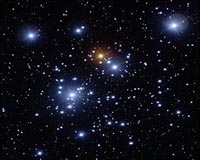 |
Paris, France (SPX) Nov 04, 2009 Astronomers have tracked down a gigantic, previously unknown assembly of galaxies located almost seven billion light-years away from us. The discovery, made possible by combining two of the most powerful ground-based telescopes in the world, is the first observation of such a prominent galaxy structure in the distant Universe, providing further insight into the cosmic web and how it formed. "Matter is not distributed uniformly in the Universe," says Masayuki Tanaka from ESO, who led the new study. "In our cosmic vicinity, stars form in galaxies and galaxies usually form groups and clusters of galaxies. The most widely accepted cosmological theories predict that matter also clumps on a larger scale in the so-called 'cosmic web', in which galaxies, embedded in filaments stretching between voids, create a gigantic wispy structure." These filaments are millions of light years long and constitute the skeleton of the Universe: galaxies gather around them, and immense galaxy clusters form at their intersections, lurking like giant spiders waiting for more matter to digest. Scientists are struggling to determine how they swirl into existence. Although massive filamentary structures have been often observed at relatively small distances from us, solid proof of their existence in the more distant Universe has been lacking until now. The team led by Tanaka discovered a large structure around a distant cluster of galaxies in images they obtained earlier. They have now used two major ground-based telescopes to study this structure in greater detail, measuring the distances from Earth of over 150 galaxies, and, hence, obtaining a three-dimensional view of the structure. The spectroscopic observations were performed using the VIMOS instrument on ESO's Very Large Telescope and FOCAS on the Subaru Telescope, operated by the National Astronomical Observatory of Japan. Thanks to these and other observations, the astronomers were able to make a real demographic study of this structure, and have identified several groups of galaxies surrounding the main galaxy cluster. They could distinguish tens of such clumps, each typically ten times as massive as our own Milky Way galaxy - and some as much as a thousand times more massive - while they estimate that the mass of the cluster amounts to at least ten thousand times the mass of the Milky Way. Some of the clumps are feeling the fatal gravitational pull of the cluster, and will eventually fall into it. "This is the first time that we have observed such a rich and prominent structure in the distant Universe," says Tanaka. "We can now move from demography to sociology and study how the properties of galaxies depend on their environment, at a time when the Universe was only two thirds of its present age." The filament is located about 6.7 billion light-years away from us and extends over at least 60 million light-years. The newly uncovered structure does probably extend further, beyond the field probed by the team, and hence future observations have already been planned to obtain a definite measure of its size. Share This Article With Planet Earth
Related Links ESO Astronomy News from Skynightly.com
 Opening Up A Colourful Cosmic Jewel Box
Opening Up A Colourful Cosmic Jewel BoxParis, France (SPX) Oct 30, 2009 The combination of images taken by three exceptional telescopes, the ESO Very Large Telescope on Cerro Paranal , the MPG/ESO 2.2-metre telescope at ESO's La Silla observatory and the NASA/ESA Hubble Space Telescope, has allowed the stunning Jewel Box star cluster to be seen in a whole new light. Star clusters are among the most visually alluring and astrophysically fascinating objects in ... read more |
|
| The content herein, unless otherwise known to be public domain, are Copyright 1995-2009 - SpaceDaily. AFP and UPI Wire Stories are copyright Agence France-Presse and United Press International. ESA Portal Reports are copyright European Space Agency. All NASA sourced material is public domain. Additional copyrights may apply in whole or part to other bona fide parties. Advertising does not imply endorsement,agreement or approval of any opinions, statements or information provided by SpaceDaily on any Web page published or hosted by SpaceDaily. Privacy Statement |